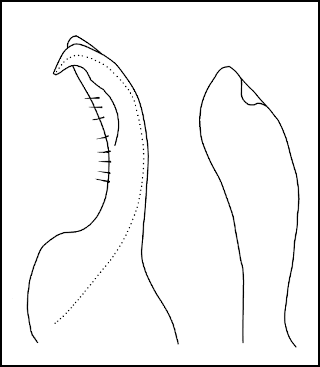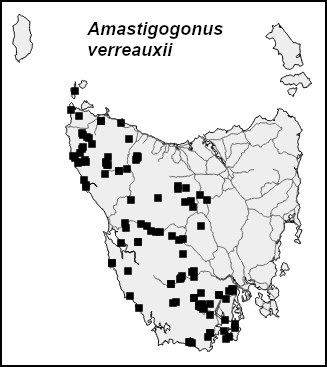Spirostreptida: Iulomorphidae: Amastigogonus
Back to Spirostreptida key
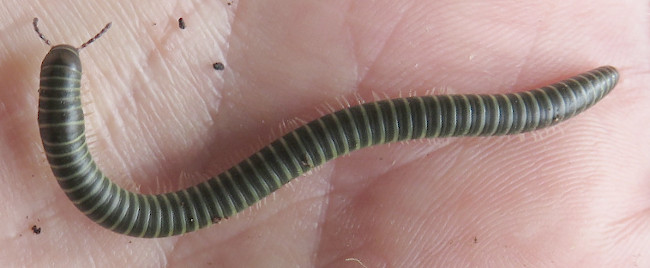
Amastigogonus fossuliger Verhoeff, 1944
A species of Amastigogonus was the first Tasmanian millipede to be scientifically described: Iulus verreauxii in 1847. The genus includes the longest millipedes in Tasmania, to ca 90 mm. Although Amastigogonus species have not yet been recorded from King Island or the Furneaux Group, they occur in forest and woodland everywhere else in Tasmania, including the larger offshore islands, and can be very abundant locally. Amastigogonus species wander at night, climb trees and leave characteristic masses of granular feces in and under rotting logs.
Amastigogonus species and other Spirostreptida have strong-smelling, yellow-coloured defensive secretions that stain human skin a dark purple. The secretions contain benzoquinones. Other millipedes (and other arthropods) should always be preserved separately from Spirostreptida, as benzoquinones can harden alcohol-preserved specimens and stain them a dark red.
The photographs and drawings below show the isolated gonopods of Amastigogonus hardyi in posterior view (left) and anterior view (right). Males of Spirostreptida actually have two pairs of gonopods. The posterior ones (po) are taxonomically important but tiny, and species are separated on differences in structure of the big anterior gonopods. In the gonopod drawings for the different Amastigogonus species (except A. insularis) I show two parts of the right anterior gonopod: a medial (from the midline) view of the top of the telopodite (te), and a lateral (from the outside) view of the top of the coxite process (cxp). You may need to use fine needles to separate these parts in order to see them clearly in preserved specimens. The gonopod details shown are consistent across the range of each species.
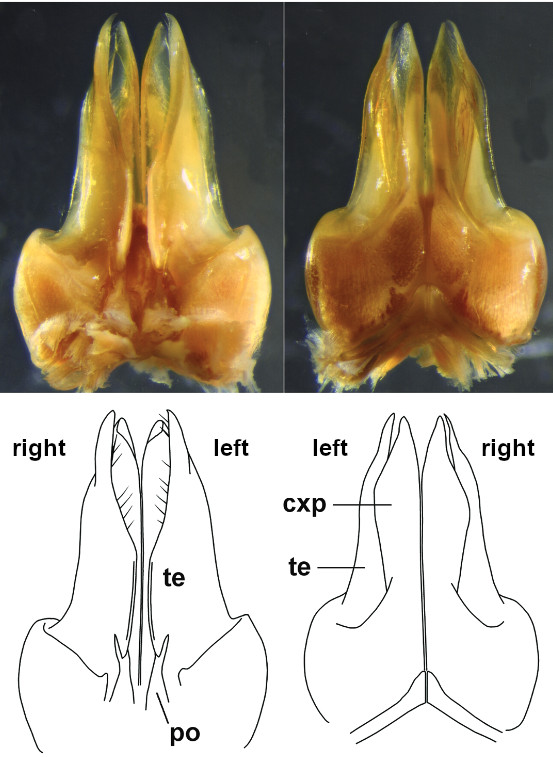
Amastigogonus danpicola Mesibov, 2017
Found in eucalypt forest over ca 1000 sq. km. on the East Coast, mainly in the Apsley, Douglas, St Pauls and Swan River catchments, from near sea level to at least 600 m. Possibly parapatric with A. elephas in the upper St Pauls River catchment and with A. michaelsae near Swansea. Sympatric with A. fossuliger and A. orientalis. The curious name comes from an abbreviation of Douglas-Apsley National Park + -icola, "dweller". This species is abundant in the Park.
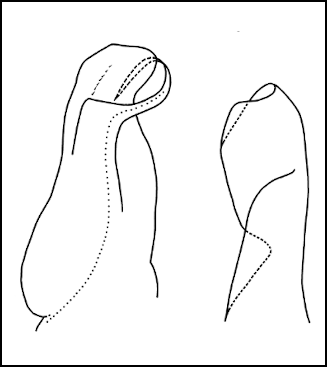

Amastigogonus elephas Mesibov, 2017
In eucalypt forest at the eastern end of the Fingal Valley on the East Coast, to at least 700 m. Amastigogonus elephas may be parapatric with A. danpicola in the upper St Pauls River catchment.

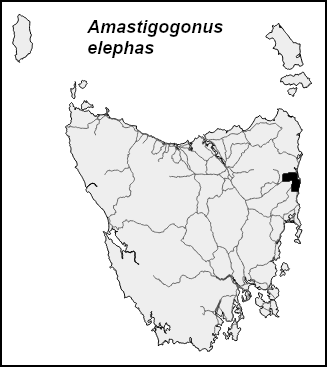
Amastigogonus fossuliger Verhoeff, 1944
Widespread in the eastern half of Tasmania in dry and wet eucalypt forest from near sea level to at least 1050 m, extending across the Central Plateau to the Cradle Mountain area. Parapatric with A. hellyeri along the Mersey Break, a well-documented faunal divide for millipedes in north central Tasmania. Co-occurs with A. tasmanianus in the northeast. Overlaps with A. verreauxii on the Central Plateau and possibly in southern Tasmania, and to a small extent with A. danpicola southeast of the Fingal Valley. The far southern record on the distribution map is for two A. fossuliger males found on the verandah of a house at Francistown; this may represent an accidental translocation. This species was first described from the Lake Leake area.
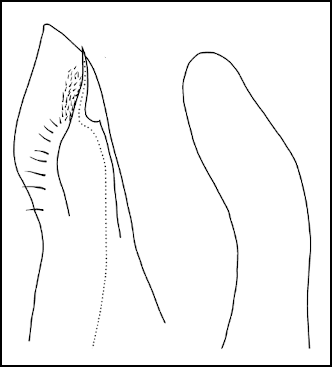

Amastigogonus hardyi (Chamberlin, 1920)
First collected by G.H. Hardy ca 1913-1915 and described from "Tasmania". Currently known only from eucalypt forest at two sites in the Hobart metropolitan area: Mt Nelson (including 1973 collections at this type locality for the synonym A. nichollsii) and Mt Rumney.
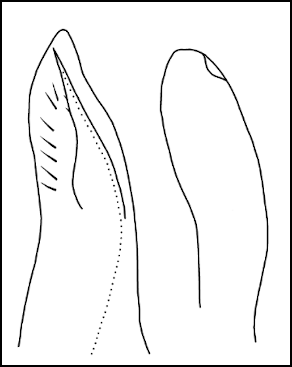

Amastigogonus hellyeri Mesibov, 2017
Found in eucalypt forest and rainforest in the northwest, from near sea level to at least 760 m. Meets A. fossuliger parapatrically along the Mersey Break and overlaps to a small extent in the far northwest with A. verreauxii.

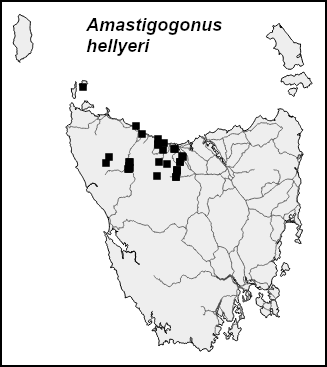
Amastigogonus insularis Mesibov, 2017
This relatively small species has an unusually short coxite process on the anterior gonopod (see gonopod image) and is so far known only from Schouten and Tasman Islands.
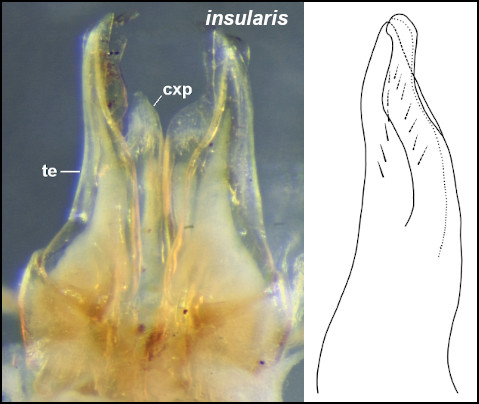
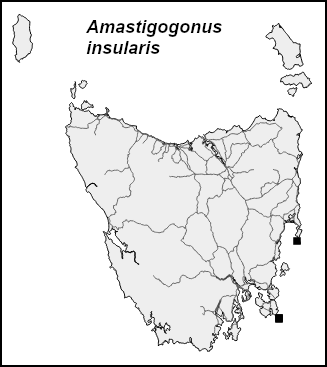
Amastigogonus michaelsae Mesibov, 2017
Found in eucalypt forest in the southeast from Coles Bay south to the Nugent area, including Maria Island, from sea level to at least 590 m. Possibly parapatric with A. danpicola near Swansea, and parapatric or overlapping with A. orientalis west of Triabunna.
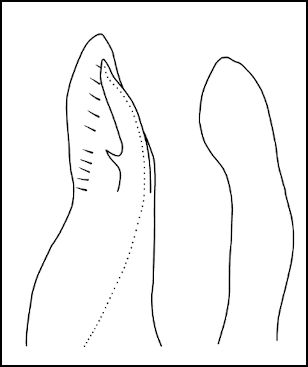

Amastigogonus orientalis Mesibov, 2017
In eucalypt forest over a ca 100 km linear extent in the Eastern Tiers, from ca 150 to at least 600 m elevation; the disjunction in the distribution map is likely to be a sampling artefact. Possibly parapatric with A. elephas near Gray; overlapping to a small extent with A. danpicola in the Douglas-Apsley National Park and with A. fossuliger northwest of Triabunna; parapatric or overlapping with A. michaelsae in the southern portion of the Eastern Tiers.
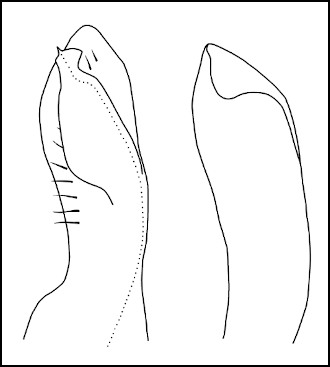

Amastigogonus peninsulensis Mesibov, 2017
In eucalypt forest on Forestier and Tasman Peninsulas from near sea level to at least 260 m.

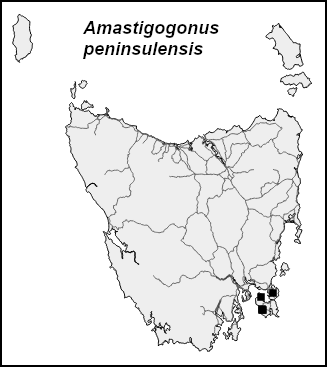
Amastigogonus tasmanianus Brölemann, 1913
Described from "Tasmania", but I suspect the types were collected near Launceston. In eucalypt forest and rainforest at scattered locations in the northeast, from ca 100 m to at least 1000 m. Co-occurs with A. fossuliger.
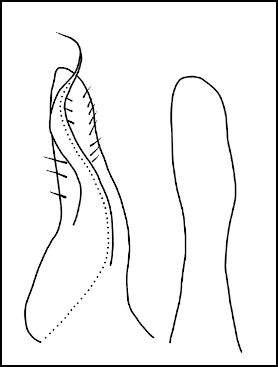

Amastigogonus verreauxii (Gervais, 1847)
Named for the naturalist Jules Pierre Verreaux, who collected this species on Mt Wellington ca 1843 during a stay in Tasmania. Widespread in forested and some non-forested habitats in the west and south and on the Central Plateau, from sea level to at least 1260 m; also found on Hunter Island in western Bass Strait. Overlaps (with some parapatry?) with A. hellyeri in the northwest, and with A. fossuliger on the Central Plateau.
